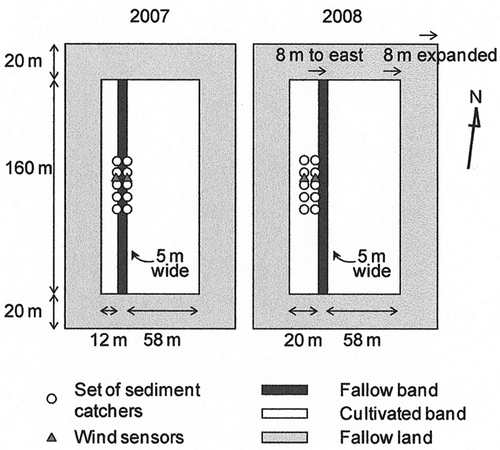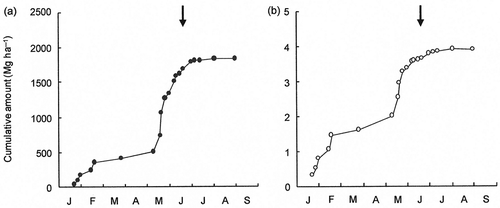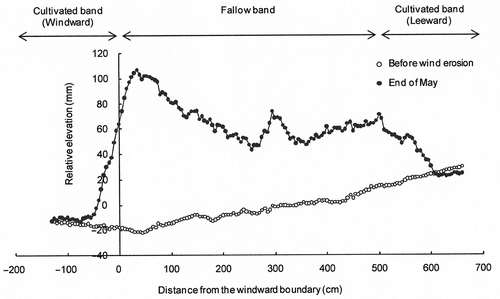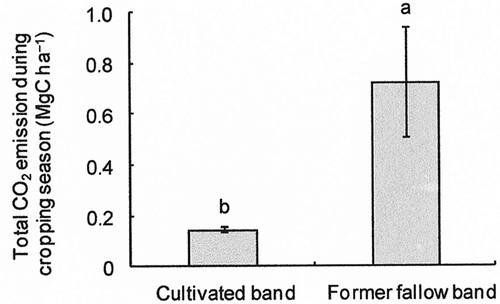Abstract
Wind erosion is a major contributor to desertification in the Sahel. Although three effective countermeasures for wind erosion (i.e. ridging, mulching with post-harvest crop residue, and windbreaks) have been proposed, they are not practical for Sahelian farmers. Therefore, we designed a new land management practice, termed the “Fallow Band System,” which can be used for both controlling wind erosion and improving soil fertility and crop production. This method does not impose additional expense and labor requirements on Sahelian farmers who are economically challenged and have limited manpower. The objective of this study was to evaluate the effects of this system on wind-erosion control and soil-fertility improvement. We conducted field experiments at the International Crops Research Institute for the Semi-Arid Tropics West and Central Africa and showed that (i) a fallow band can capture 74% of wind-blown soil particles and 58% of wind-blown coarse organic matter, which suggests that it can effectively control wind erosion, (ii) the amount of soil nutrients available for crops in a former fallow band was increased by the decomposition of trapped soil materials containing considerable amounts of nutrients, and (iii) the amount of soil water available for crops in a former fallow band was increased by the trapped wind-blown soil materials through improvement of rainwater infiltration into surface soil. These results lead to the conclusion that the “Fallow Band System” can be useful for preventing desertification and improving soil fertility in the Sahel, West Africa.
Introduction
Wind erosion is a major contributor to desertification (United Nations Environment Program Citation1997), particularly in the Sahel region of West Africa (Lal Citation1993). Topsoil, which typically contains more nutrients than subsoil, is detached and removed from arable land by wind. Thus, wind erosion affects the soil nutrient level (Daniel and Langham Citation1936; Zobeck and Fryrear Citation1986; Sterk et al. Citation1996; Larney et al. Citation1998; Bielders et al. Citation2002) and soil productivity (Lyles Citation1975; Larney et al. Citation1998). Moreover, abrasion and burial by the wind-blown sand can damage pearl millet stands (Pennisetum glaucum (L.) R. Br.) (Michels et al. Citation1993, Citation1995a), a staple cereal crop in the Sahel.
Wind erosion can be effectively controlled by reducing wind velocity at the soil surface or by creating sufficient resistance to wind forces on the soil surface. The available methods include roughening of the soil surface, maintaining soil cover, or establishing wind barriers (Tibke Citation1988). In the Sahel, effects of the three primary methods [i.e. ridging, mulching with post-harvest crop residue, and windbreaks (including wind barrier and shelterbelt)] against wind erosion have been tested mainly at experimental research stations (Sterk Citation2003). Bielders et al. (Citation2000) reported that the 0.2-m-high ridges perpendicular to the prevailing erosive wind direction reduced soil loss in a pearl millet field by 57% compared with the control plots (no ridges), but the efficiency was declined to less than 15% after 100 mm of cumulative rainfall because the ridges were rapidly destroyed by rain on a sandy soil with low structural stability. Although ridging is effective for wind erosion control, most Sahelian farmers do not possess sufficient labor (Matlon Citation1987; Nagy et al. Citation1988; Ruthven and David Citation1995) and animal traction (Nagy et al. Citation1988; Baidu-Forson and Renard Citation1996; International Livestock Research Institute Citation2004) to employ this method; thus, ridging is not practical for farmers under the current conditions.
The effect of mulching with post-harvest millet residue on wind erosion control has been demonstrated by Geiger et al. (Citation1992), Michels et al. (Citation1995b), Lamers et al. (Citation1995), Sterk and Spaan (Citation1997), Buerkert and Lamers (Citation1999), and Bielders et al. (Citation2000) in the Sahel. In summary, application of 1500 to 2000 kg ha−1 of millet residue reduced soil flux by 46–64% compared with the control plots. However, 500–1000 kg ha−1 of post-harvest millet was not always effective in reducing soil flux. Although mulching with a large quantity of post-harvest millet residue is effective, application of 1500 to 2000 kg ha−1 is not realistic in the Sahel because the productivity of very sandy soils is too low and millet residue is extensively used as animal feed, fuel, and constructing material (Lamers and Feil Citation1993; Michels et al. Citation1995b; Schlecht and Buerkert Citation2004).
The effect of windbreaks on controlling wind erosion in the Sahel has been investigated by several groups. Banzhaf et al. (Citation1992) reported that a windbreak of 0.6-m-high and 5-m-wide fallow vegetation reduced soil mass transport by 70%. Mohammed et al. (Citation1995) showed that a windbreak of 6.7-m-high and 300–500-m-wide Eucalyptus microtheca growth reduced soil mass transport by 42%. Michels et al. (Citation1998) revealed that a windbreak of Andropogon gayanus and Bauhinia rufescens growth reduced annual soil flux by 6–55% and 47–77%, respectively. However, windbreaks have not been adopted by Sahelian farmers (Bielders et al. Citation2001). Bielders et al. (Citation2001) considered the reasons for this non-adoption to be lack of plant material, lack of training and development project support, reduction in cropping area, land tenure problems (ownership of trees), and the need for protection against grazing livestock.
Effective measures for wind erosion control have been proposed and their effects have been demonstrated. However, none of these measures have been adopted by Sahelian farmers (Rinaudo Citation1996). This does not mean that farmers are ignorant of wind-erosion problems. Studies in Niger showed that most farmers recognize the severe damage caused by wind erosion, are aware of wind erosion control techniques, and many have even tried to apply one or several of these techniques (Taylor-Powell Citation1991; Sterk and Haigis Citation1998; Bielders et al. Citation2001; Schlecht and Buerkert Citation2004). The main reason for non-adoption may be that developers and/or extension workers of these techniques did not give sufficient attention to their practicality for farmers.
According to our previous wind erosion studies in the Sahel (Ikazaki et al. Citation2011b,c) using the Aeolian Materials Sampler (AMS; Ikazaki et al. Citation2009, Citation2010, Citation2011a), (1) significant amounts of soil and associated nutrients were transported from cultivated fields during the wind erosion events, and (2) most wind-blown soil materials were trapped by the 5-m-wide herbaceous fallow vegetation located leeward of the field. On the basis of these results, we propose a new land management practice, called the “Fallow Band System,” which will be useful for both wind erosion control and improvement of soil fertility and crop production in the Sahel. In designing the “Fallow Band System,” we carefully considered its practicality for Sahelian farmers. The objective of this study was to verify the effectiveness of this system in controlling wind erosion and improving soil fertility.
Outline of the “Fallow Band System”
Although wind is the driving force of wind erosion, in the presence of a proper windbreak, it can be the agent that gathers soil particles and soil nutrients sparsely distributed across a field. The “Fallow Band System” may be considered as a shifting herbaceous windbreak. shows this system in a temporal sequence of land use. (A) In this system, 5-m-wide herbaceous fallow bands are arranged at a right angle to the erosive wind direction (east) in a cultivated field during the rainy season. Fallow bands can be easily created by skipping the usual seeding and weeding (by doing nothing); thus, this system does not impose any additional expenses and labor requirements on Sahelian farmers who are economically challenged and have limited manpower (Matlon Citation1987; Nagy et al. Citation1988; Ruthven and David Citation1995). This characteristic is crucial for the practicality of this system for Sahelian farmers. Crops are cultivated in the remainder of the field by using a conventional method (“cultivated band,” as shown in ). Fallow bands are maintained during the subsequent dry season so that they will trap wind-blown soil materials and control wind erosion in the field. (B) During the next rainy season, new fallow bands are established windward of the former fallow bands, where in turn crops are cultivated as well as in the cultivated bands. (C) Step (B) is repeated each year. Sahelian farmers have groundwork for accepting this system. According to Sterk and Haigis (Citation1998), most Sahelian farmers believe that soil loss results in reduced fertility and lower production, whereas deposition of wind-blown soil materials improves soil fertility and productivity. Bielders et al. (Citation2001) also reported that some farmers in the Sahel omit second weeding in unproductive areas because weeds will increase soil cover during the subsequent dry season and help reduce erosion and trap sediment from adjacent unprotected areas. Therefore, Sahelian farmers will recognize that the “Fallow Band System” has great potential for wind erosion control and improvement of soil fertility and crop production.
Potential effects on improvement of soil fertility
The “Fallow Band System” can improve soil chemical and physical properties. Because the trapped wind-blown soil materials by fallow bands contain considerable amounts of nutrients, soil chemical properties will be improved, resulting in better crop production in the former fallow bands. According to Buerkert and Lamers (Citation1999), wind-blown soil materials trapped by polyethylene plastic tubes in cultivated fields improved soil chemical characteristics (e.g. slight, but not significant, increase in organic carbon and total nitrogen content, and significant increase in available phosphorus, base cations, and pH) of the topsoil of 0 to 0.1 m and promoted early-season growth of pearl millet.
Soil physical properties can be improved by covering the crust layer or “hardpan” layer of the soil surface with trapped coarse soil particles. Soil crusts, mainly structural crusts, are often found in sandy Sahelian soils (Hoogmoed and Stroosnijder Citation1984; Valentin Citation1991; Tanaka Citation1996; Graef and Stahr Citation2000). Thus far, many studies (McIntyre Citation1958; Hoogmoed and Stroosnijder Citation1984; Valentin Citation1991; Casenave and Valentin Citation1992) have described that soil crust inhibits rainwater infiltration into the soil. According to Valentin and Bresson (Citation1992) and Bielders and Baveye (Citation1995a,Citationb), a thin and dense plasmic (fine particle) layer or clay band is formed at a depth of a few millimeters by the clay and silt particles that existed in the top layer as coatings around sand grains and were washed out by raindrops. We hypothesized that covering the soil crust with trapped coarse soil particles that have high hydraulic conductivity would increase the hydraulic conductivity of the surface soil and improve the infiltration of rainwater; this hypothesis was based on our previous field observations as well as studies by Buerkert and Lamers (Citation1999) and Ribolzi et al. (Citation2006), who observed increased soil water content or soil permeability in surface soil where wind-blown soil materials had settled.
Materials and Methods
Study site
Field experiments were conducted from 2006 to 2008 at the International Crops Research Institute for the Semi-Arid Tropics West and Central Africa (IWCA) in Niger [13°14′N, 2°17′E, 235 m above sea level (a.s.l.)]. The climate in the IWCA is typical of the Sahelian zone with high temperature, one rainy season from May to September, and one dry season. Mean annual temperature is 29°C (mean value from 1983 to 2010), and mean annual rainfall is 550 ± 115 mm (mean ± standard deviation for the values from 1983 to 2010) in the IWCA. Soil at the experimental site was classified as sandy, siliceous, and isohyperthermic Psammentic Paleustalf of the Labucheri soil series (West et al. Citation1984; “labu cheri” means red soil in local language) and topsoil of 0 to 0.05 m contained 95% (w/w) sand, 2% (w/w) silt, 3% (w/w) clay, 3 g kg−1 total carbon, and 0.3 g kg−1 total nitrogen; the pH (H2O) was 6.3.
Layout of the experimental plot
shows the layout of the experimental plot in 2007 and 2008. Before the experiment, the plot was fallow for nine years up to 2006. Pearl millet was planted at the center of the plot (1.2 ha, 160 m × 75 m) from 2006 and was grown using the farming methods employed by farmers near the IWCA. This cultivated section was surrounded by 20-m-wide herbaceous fallow land to prevent the entry of wind-blown soil materials from outside the plot. Similar to other regions in the Sahel, farming practices were limited to hand-hoe sowing in untilled and unfertilized land and two manual push-hoe weedings per cropping season. The plot was flat (less than 1° grade) and smooth (not undulated). In 2007, a fallow band (160 m × 5 m) was established in the cultivated section during the rainy season at a right angle to the major direction of erosive storms (east wind), and the width of the windward cultivated band was set to 58 m. In 2008, a new fallow band was created 8 m east of the former band. To retain the width of windward cultivated band (58 m), both the cultivated section and the surrounding fallow land were extended 8 m to the east.
Effectiveness in wind erosion control
The effect of the “Fallow Band System” on wind erosion control was assessed on the basis of the fallow band's capacity to trap incoming wind-blown soil materials. This was calculated by subtracting mass transport at the leeward boundary of the fallow band from that at the windward boundary. Mass transport was measured for every erosion event in 2008 by using the AMS and Big Spring Number Eight (BSNE) sampler (Fryrear Citation1986) as the same method in Ikazaki et al. (Citation2011b,c). The BSNE sampler is the most-used sediment catcher in field conditions. Owing to its near-isokinetic characteristic (Fryrear Citation1986; Shao et al. Citation1993; Goossens et al. Citation2000), the BSNE sampler can measure mass flux of wind-blown soil materials at the height of >0.05 m with high accuracy. The AMS was designed to measure that at the height of 0 to 0.05 m. Five sets of three AMSs and one BSNE sampler were installed in November 2007 windward and leeward of the fallow band at approximately 10 -m intervals where the samplers were unlikely to be seriously affected by water erosion (). Of the three AMSs, one was directed northeast, another to the east, and the third to the southeast. After each erosion event, the trapped materials were collected from samplers and separated into coarse organic matter [COM; conceptually similar to the free light fraction defined by Six et al. (Citation1998)] and soil particles by sieving and dry panning, since their modes of transport by wind are different (Ikazaki et al. Citation2009, Citation2011a). Separated COM and soil particles were then air-dried and weighed. The air-dried weight of COM and soil particles was used in this study because the difference between the oven-dried and air-dried weight is normally less than 1%, which can be attributed to the hot, dry climate and the very sandy soil in the Sahel. After every collection, the position of the AMS apron and the trap heights of the BSNE sampler were checked and adjusted if necessary. One set of wind velocity/direction sensors (034B/014A; Met One Instruments, Inc., Grants Pass, OR, USA) mounted at heights of 0.14, 0.30, 0.60, and 2.0 m was installed windward of the fallow band and another set of wind sensors mounted at heights of 0.14, 0.30, 0.60, 1.0, and 2.0 m was installed leeward of the fallow band in 2007 (). To collect data from erosive storms under a bare condition (no vegetation through the year), another set of wind velocity/direction sensors mounted at heights of 0.14, 0.30, 0.60, and 2.0 m was installed at the center of the 80 m × 80 m bare plot next to the experimental plot in 2007. Wind speed and direction were measured every 10 s and recorded as a 1-min vector mean with a data logger (CR10X; Campbell Scientific, Inc., Logan, UT, USA). The wind data collected at the windward and leeward boundaries were used to determine the AMS trapping efficiency for the mass flux of COM and soil particles by using the relationship derived from the wind tunnel experiments by Ikazaki et al. (Citation2009). Then, mass flux data obtained with the AMS were corrected by the trapping efficiency. The trapping efficiency of the BSNE sampler was considered to be unity in every storm event, according to the method by Bielders et al. (Citation2000, Citation2002) and Rajot et al. (Citation2003). The biomass (total dry matter) of the fallow band established in 2007 was 1.5 Mg ha−1 in January 2008.
Surface elevation was measured using four line transects between each set of sediment catchers from 1.3 m windward to 1.6 m leeward of the fallow band (totally 7.9 m) in November 2007 (before wind erosion started) and at the end of May 2008 (before sowing). Then, changes in micro-topography were estimated.
Effectiveness in improvement of soil fertility
The effects of the system on soil fertility were evaluated by determining the changes in soil chemical and physical properties. These measurements were also conducted in 2008. Improvement of soil chemical properties was verified by measuring the following values: (1) total carbon and nitrogen content of the wind-blown soil materials trapped by the former fallow band (fallow band made in 2007) by using a CN elemental analyzer (VarioMAX CN; Elemental Analysensystem GmbH, Hanau, Germany); (2) the decomposition rate of trapped COM during the cropping season by using a litter bag method, and (3) soil respiration during the cropping season in the former fallow band and cultivated band by using a closed-chamber method with root respiration excluded.
In the litter bag experiment, we used COM collected from the topsoil of cultivated fields at the IWCA in January 2006 (before the first erosion event). Litter bags with a mouth of 0.10 m × 0.10 m were constructed from nylon wire mesh with a mesh size of 0.18 mm to exclude decomposition by termites. Coarse organic matter is free organic debris with a mean diameter of 1 to 2 mm (Ikazaki et al. Citation2009) and is often incorporated into soil, thereby preventing termite attacks. Thirty litter bags were filled with 10 g of oven-dried COM (equivalent to 10 Mg ha−1), and 10 of these bags were installed at depths of 0.02, 0.05, and 0.1 m in the former fallow band soon after pearl millet was planted in 2008. All bags were sampled after harvesting. Undecomposed COM was carefully separated from the litter bags and roots and soil particles were removed. The cleaned samples were placed in paper bags and oven-dried at 65°C for more than 48 h to determine the remaining COM mass.
The carbon dioxide (CO2) efflux rate as soil respiration was measured during the rainy season in 2008 by using a closed-chamber system (Funakawa et al. Citation2006; Sugihara et al. Citation2010). Eleven measurements were carried out in the morning (between 8:15 and 10:00) throughout the cropping season. Because soil respiration consists of both plant-root respiration and microbial respiration, plant-root respiration was excluded using the trenching method reported by Shinjo et al. (Citation2006). In May 2008 (before sowing), four polyvinylchloride cylinders (diameter, 0.15 m; length, 0.25 m) were inserted into the soil to a depth of 0.12 m in the cultivated band, whereas eight cylinders (diameter, 0.15 m; length, 0.30 m) were inserted to a depth of 0.17 m in the former fallow band, because wind-blown sediments were deposited on the former band and the surface elevation appeared to increase by approximately 0.05 m. The enclosed soil was later supported with a fine stainless steel wire mesh at the bottom of the cylinders. For each measurement, cylinders with soil were removed and covered with a plastic sheet at the bottom to exclude root respiration. Gases were sampled in Tedlar® Bags (Sanplatec Co., Ltd., Osaka, Japan) at 0 and 60 min after the top of the cylinder was covered with a plastic sheet. After sampling the gases, the plastic sheets were removed and the cylinders were returned to the soil body, allowing free water percolation. The CO2 efflux rate was calculated on the basis of the increase in CO2 concentration in the cylinder after 60 min. Gas samples were analyzed with an infrared CO2 controller (ZFP9AA11; Fuji Electric, Tokyo, Japan). Total CO2 emission during the cropping season was calculated using the relationship between the CO2 efflux rate and the soil volumetric water content reported by Rey et al. (Citation2011) (soil temperature was statistically rejected and thus not used). Soil volumetric water content was automatically recorded with water-content reflectometers (CS 616; Campbell Scientific) at a depth of 0 to 0.1 m. For sensor calibration, soil temperature was measured at a depth of 0.02 to 0.07 m with thermistor thermometers (108; Campbell Scientific), and 12 actual measurements of soil volumetric water content at a depth of 0 to 0.1 m were conducted with 0.1-L metal cores.
Improvement of soil physical properties was evaluated by measuring (1) the bulk density of trapped wind-blown soil materials in the former fallow band and topsoil of 0 to 0.05 m in the cultivated band by using 0.1 L (height, 0.050 m) and 0.05 L (height, 0.025 m) metal cores (n = 31), (2) the particle-size distribution of trapped wind-blown soil particles in the former fallow band and topsoil of 0 to 0.05 m in the cultivated band by using flat sieves (mesh size of 53, 140, 250, 500, 1000, and 2000 µm) and the pipette method (<2 µm, <20 µm) (n = 5, six of the 30 samples were mixed to create five composite samples), (3) the field hydraulic conductivity of surface soil in the former fallow band and cultivated band by using disk infiltrometers (Mini-Disk Infiltrometer; Decagon Devices, Inc., Pullman, WA, USA) (n = 31), and (4) the volumetric water content in surface soil of 0 to 0.3 m by using a CS 616 (0–0.1 m) and an Easy-AG 1358 (0.1–0.3 m; Sentek Sensor Technologies, Pty. Ltd., SA, Australia) (n = 1 for the cultivated band and n = 2 for the former fallow band). Similarly, soil temperature was measured with thermistor thermometers, and 12 actual measurements of soil volumetric water content were conducted to calibrate the sensors. Both soil water content and temperature were measured and recorded every 1 min using a data logger. Additionally, the soil surface was visually observed to determine whether the structural crust was formed.
Statistical analysis
Statistical analysis was performed using SYSTAT 11.0 (2008; Systat Software, Inc., Chicago, IL, USA). The distribution normality of each group in each measurement item was assessed using the Kolmogorov–Smirnov test. When all groups exhibited a normal distribution, homogeneity of variances between groups was verified by the F test if the number of the groups was two and by the Bartlett test if the number was three. Depending on the distribution of the groups and the homogeneity of the variances between groups, the Student's t test, Welch's t test, or Mann–Whitney's U test was used to determine the statistical difference of the mean values between the two groups. To compare more than two groups, one-way analysis of variance (ANOVA) or the Kruskal–Wallis test was first employed; when a significant difference was detected, a post hoc test was performed using the Tukey HSD (Honestly Significant Difference) test or Scheffe test, depending on the distribution of the groups and homogeneity of the variances among groups. Significance was defined as P < 0.05 for all tests.
Results and Discussion
Recorded erosion events
Wind data of the recorded erosion events collected from the bare plot are listed in . There were 20 erosion events in 2008. On the basis of the Bagnold expression (Bagnold Citation1941), the summation of wind power in the erosion events was 6048 kJ m−2, which was larger than that in 2005 (4197 kJ m−2), 2006 (3632 kJ m−2), and 2007 (4711 kJ m−2).
Table 1. Data of wind erosion events in 2008
Effectiveness in wind erosion control
Loss of soil particles and COM from the cultivated band, which was measured windward of the fallow band, was estimated to be 213 Mg ha−1 and 600 kg ha−1, respectively (). Loss of soil particles in 2008 was approximately three times as much as that in 2005 (58 Mg ha−1), 2006 (80 Mg ha−1), and 2007 (79 Mg ha−1) (Ikazaki et al. Citation2011b,c). This severe wind erosion was because of the higher wind power in 2008 and erosive storms that were not accompanied by rain in May and June. As described in Sterk (Citation2003), erosive storms in the Sahel are often followed by heavy rain, which inhibits further wind erosion. In 2008, unlike in 2005, 2006, and 2007, strong wind storms in May and June were often not followed by rain, and wind erosion was not reduced by soil wetness. also shows loss of soil particles and COM from the fallow band, which was measured leeward of the fallow band (the mass of soil particles and COM passed through the fallow band). The amount of soil particles and COM trapped by fallow vegetation can be calculated by subtracting the loss from the fallow band from that from the cultivated band ().
Figure 3. Cumulative loss of (a) soil particles and (b) coarse organic matter (COM) from the cultivated band and fallow band. Arrows represent the sowing date (on June 19, 2008). Pearl millet was harvested at the middle of October.
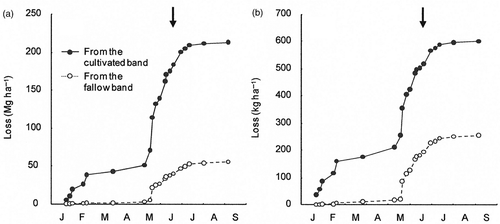
The trapping efficiencies of the fallow band for incoming wind-blown soil particles and COM for each erosion event are shown in . Both trapping efficiencies decreased over time and became negative in September. This was likely due to two reasons: (i) strong wind and the accompanying wind-blown soil particles lodged the vegetation of the fallow band in the rainy season, weakening the trapping capacity of fallow vegetation, and (ii) the increasing surface elevation caused by the trapped wind-blown soil materials (described later) sharply lowered the trapping capacity, as reported by Hagen et al. (Citation1972). As a whole, the fallow band trapped 74% of annual incoming soil particles and 58% of annual incoming COM, demonstrating that the “Fallow Band System” is effective in controlling wind erosion. The former value (74%) is similar to the efficiency of the 5-m-wide fallow vegetation windbreak (70%) described by Banzhaf et al. (Citation1992) and higher than the efficiency of surface mulching (46–64%, as mentioned earlier). This higher efficiency, compared with surface mulching, corresponded to the results in Chepil and Woodruff (Citation1963), Siddoway et al. (Citation1965), and Bilbro and Fryrear (Citation1994), which showed that the wind erosion controlling efficiency of standing residue was higher than that of flattened one. The trapping efficiency of the fallow band in this study (74% and 58% for annual incoming soil particles and COM, respectively) was lower than that of the 5-m-wide fallow land in Ikazaki et al. (Citation2011b,c) (93% and 97%, respectively). This may be due to the fact that the biomass of the fallow band (1.5 Mg ha−1) was lower than that of the 5-m-wide fallow land (2.5 Mg ha−1).
Figure 4. Trapping efficiency of the fallow band for incoming (a) soil particles and (b) coarse organic matter (COM). Arrows represent the sowing date (on June 19, 2008). Pearl millet was harvested at the middle of October.
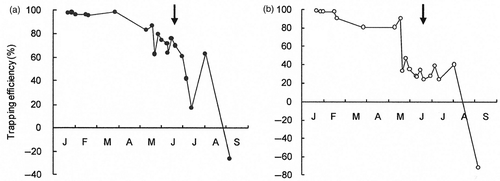
shows the cumulative amount of trapped soil particles and COM in a hectare of fallow band (in , loss was expressed in a hectare of a cultivated band). The total amount of trapped soil particles and COM was 1830 Mg ha−1 and 4.0 Mg ha−1, respectively. Reflecting this enormous deposition, the surface elevation of the fallow band at the end of May (before sowing) rose by 73 mm on average (). This value was higher than the values in the mulch plot where 2000 kg ha−1 of banded millet stover was applied (less than 1 mm year−1) (Bielders et al. Citation2000) and where millet stover grown in the previous rainy season was applied (36 mm year−1) (Geiger et al. Citation1992), but similar to the value in the mulch plot where 2000 kg ha−1 of millet stover was applied by broadcasting (62 mm year−1) (Buerkert and Lamers Citation1999), though the fetch (the unobstructed distance over which wind passes before reaching a plot or fallow band) was different in these studies; thus, these results cannot be directly compared.
Improvement in soil chemical properties
The amount of carbon and nitrogen trapped by the fallow band was estimated to be 10 Mg ha−1 and 970 kg ha−1, respectively (expressed in a hectare of fallow band). Of the 10 Mg ha−1 of carbon, 8.7 Mg ha−1 (87%) was associated with trapped soil particles and 1.3 Mg ha−1 (13%) was associated with trapped COM. Of the 970 kg ha−1 of nitrogen, 910 kg ha−1 (94%) was associated with trapped soil particles and 60 kg ha−1 (6%) was associated with trapped COM. The carbon/nitrogen ratio in trapped soil particles and COM was 9.5 and 21.5, respectively. The latter value was nearly equivalent to the carbon/nitrogen ratio of the light fraction (<1.6 Mg m−3) in topsoil of a cultivated field at the IWCA (22; Sugihara 2011, personal communication) and was less than or equal to the critical carbon/nitrogen ratio required for short-term net nitrogen mineralization (Harmsen and Van Schreven Citation1955; Alexander Citation1977).
Weight losses of COM in litter bags during the cropping season increased with depth of installation (). This may be because soil water content increased sharply with depth of surface soil during the cropping season. Franzluebbers et al. (Citation1994) and Cuenca et al. (Citation1997) reported that the soil water content in topsoil of 0.05 to 0.10 m remained at a higher level than that of 0 to 0.05 m during most of the cropping season in sandy Sahelian soils. Additionally, we often observed a dry sand layer at the topsoil of 0 to 0.03 m. The weight loss at 0.02 m was 22 ± 2% (mean ± standard error), which was similar to the results of Esse et al. (Citation2001) reporting that only 20% of cattle manure (unknown carbon/nitrogen ratio) was decomposed during the cropping season in the soil surface with limited termite activity. The loss at 0.05 m was 35 ± 2% (mean ± standard error), which was corresponded to the results of Fatondji et al. (Citation2009) who showed 35% of cattle manure (carbon/nitrogen ratio = 21) installed at a depth of 0.05 m was decomposed during the cropping season, when termite activity was controlled by pesticide application.
Figure 7. Weight loss of coarse organic matter (COM) in litter bags during cropping season at depths of 0.02, 0.05, and 0.10 m. Error bars indicate standard error. Mean values with different letters are significantly different at the P < 0.05 significance level.
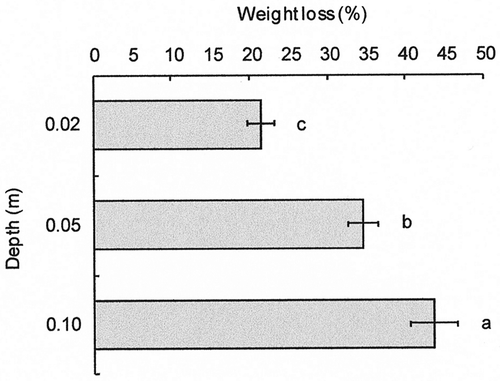
Total soil respiration during cropping season, excluding root respiration, was 0.15 ± 0.01 Mg C ha−1 in the cultivated band and 0.70 ± 0.21 Mg C ha−1 in the fallow band (mean ± standard error; ). Few studies have measured these values in the Sahel. The former value (0.15 Mg C ha−1), measured in the cultivated band during the third year after fallow, was lower than the values measured by Kamidohzono et al. (Citation2007) (0.39 Mg C ha−1 in the continuous cultivated plot) and Shinjo (unpublished data) (0.47 Mg C ha−1 during the third year after fallow), whereas the latter value (0.70 Mg C ha−1), measured in the fallow band where 4.0 Mg ha−1 of COM was trapped, was similar to the value measured by Kamidohzono et al. (Citation2007) (0.71 Mg C ha−1 in the plot where 4.3 Mg ha−1 of pearl millet residue was applied). Respiration in the fallow band was significantly higher than that in the cultivated band due to additional decomposition of trapped soil particles and COM. If 35% (equal to weight loss at a depth of 0.05 m) of trapped COM carbon decomposes during the cropping season, 0.47 Mg C ha−1 is emitted. Therefore, this respiration difference of 0.55 Mg C ha−1 may be caused mainly by decomposition of trapped COM. We conclude that the amount of soil nutrients available for crops will increase in the fallow band because of decomposition of trapped soil particles (carbon/nitrogen ratio = 9.5) and COM (carbon/nitrogen ratio = 21.5) containing significant amounts of soil nutrients.
Improvement of soil physical properties
The bulk density of trapped wind-blown soil materials (0–0.075 m) was significantly lower than that of topsoil (0–0.05 m) in the cultivated band () because trapped materials contained a significant amount of COM with density as low as 0.3 Mg m−3.
Figure 9. Bulk density of trapped materials in the former fallow band and that of the topsoil at a depth of 0 to 0.05 m in the cultivated band. Error bars indicate standard error. Mean values with different letters are significantly different at the P < 0.05 significance level.

In trapped soil particles, fine sand (140–250 µm) content was significantly higher, whereas clay, silt, and coarse sand (500–1000 µm, 1000–2000 µm) contents were significantly lower than those in the topsoil at a depth of 0 to 0.05 m in the cultivated band (). This sorting may be because of the following reasons: (i) soil particles larger than 840 µm in diameter were non-erodible by wind (Chepil Citation1950), (ii) clay and silt-size soil particles exhibit high resistance to movement by wind (Bagnold Citation1941; Chepil and Woodruff Citation1963; Iversen and White Citation1982), and (iii) once clay and silt size soil particles are entrained by wind, they move in suspension (Udden Citation1894; Pye Citation1987; Shao Citation2000) and therefore cannot be trapped by fallow vegetation. Due to a decrease in clay and silt contents, crust formation was not observed in the former fallow band but was observed in the cultivated band. This agreed with the results of Ambouta et al. (Citation1996), who stated that soil crust will not form on soils with clay + silt content less than 5%. The clay + silt content of topsoil in the cultivated band was 6 ± 0.1% (mean ± standard error), whereas that of trapped soil particles in the former fallow bands was 3 ± 0.5%, less than the threshold content proposed by Ambouta et al. (Citation1996).
Figure 10. Particle size distribution of trapped soil particles in the former fallow band and topsoil at a depth of 0 to 0.05 m in the cultivated band. Error bars indicate standard error.

Reflecting the fact that bulk density was lower and soil crust did not form, field hydraulic conductivity of surface soil in the former fallow band was significantly higher than that in the cultivated band (). As a result, water content in the surface soil at a depth of 0 to 0.3 m in the former fallow band (n = 2, average is shown in ) was higher than that in the cultivated band (n = 1) during the early cropping season (). Buerkert and Lamers (Citation1999) also reported that the coverage of surface soil by trapped wind-blown soil materials (0.05–0.10 m deep) increased soil moisture. With reference to Mando et al. (Citation1996), they suggested that the cause of this increase was termite activity. In contrast, we could not identify termite activity in the former fallow band possibly because most COM, free organic debris with a mean diameter of 1 to 2 mm, was incorporated into soil particles, preventing termite attack. Therefore, it was concluded that soil physical properties, particularly infiltration of the rainwater, were improved and the amount of soil water available for crops was increased in the former fallow band by the cover with trapped wind-blown soil materials which have a high hydraulic conductivity.
Figure 11. Field hydraulic conductivity in the former fallow band and in the cultivated band. Error bars indicate standard error. Mean values with different letters are significantly different at the P < 0.05 significance level.
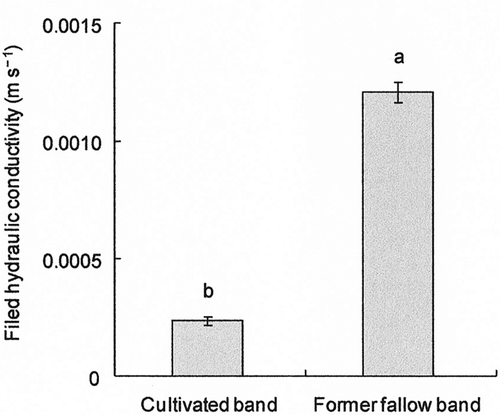
Figure 12. Volumetric water content during the early cropping season in surface soil at a depth of 0 to 0.3 m in the former fallow band and the cultivated band. Rainfall data were collected at the meteorological station at the Internal Crops Research Institute for the Semi-Arid Tropics West and Central Africa (IWCA) located approximately 1 km from experimental plots. Pearl millet was sowed on June 19, 2008.
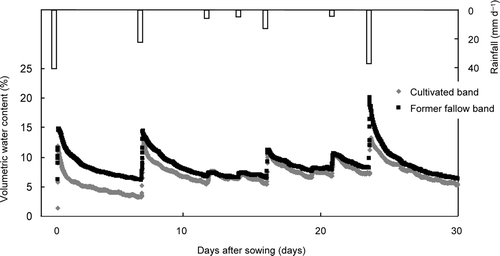
Conclusion
We proposed the “Fallow Band System,” which does not impose any additional expense and labor requirements on local farmers, for combating desertification and improving crop production in the Sahel. In this study, the effectiveness of the “Fallow Band System” with regard to controlling wind erosion and improving soil fertility was investigated. From experiments conducted at the IWCA, we demonstrated that (1) a fallow band trapped 74% of annual incoming soil particles and 58% of annual incoming COM and thus, controlled wind erosion effectively, (2) the amount of soil nutrients available for crops in the former fallow band was increased by the decomposition of trapped soil particles (carbon/nitrogen ratio = 9.5) and COM (carbon/nitrogen ratio = 21.5) containing a significant amount of nutrients, and (3) the amount of soil water available for crops in the former fallow band was increased by trapped wind-blown soil materials through improvement of rainwater infiltration into surface soil. Therefore, it was concluded that Sahelian farmers can effectively control wind erosion and improve soil fertility by using the “Fallow Band System,” a “do-nothing” practice. This improvement of soil fertility may lead to increased crop production in the former fallow band, which is discussed in a sequel paper.
Acknowledgments
This study was performed under the JIRCAS-ICRISAT collaborative project, “Improvement of Fertility of Sandy Soils in the Semi-Arid Zone of West Africa through Organic Matter Management.” Portions of this study were financially supported by the Japan Society for the Promotion of Science (JSPS) and Research Institute for Humanity and Nature (RIHN).
References
- Alexander, M , 1977. "Mineralization and immobilization of nitrogen". In: Alexander, M , ed. Introduction to Soil Microbiology, . New York: John Wiley & Sons; 1977. pp. 225–250.
- Ambouta, JMK , Valentin, C , and Laverdiere, MR , 1996. Jachère et croûte d’érosion au Sahel , Sécheresse 7 (1996), pp. 269–275, (in French with English summary).
- Bagnold, RA , , 1941: The effect of sand movement on the surface wind, In The Physics of Blown Sand and Desert Dunes, pp 57–76, Mathuen, London.
- Baidu-Forson, J , and Renard, C , 1996. Comparing productivity of millet-based cropping systems in unstable environments of the Sahel: possibilities and challenges , Agric. Syst. 51 (1996), pp. 85–95.
- Banzhaf, J , Leihner, DE , Buerkert, A , and Serafini, PG , 1992. Soil tillage and windbreak effects on millet and cowpea: I. Wind speed, evaporation, and wind erosion , Agron. J. 84 (1992), pp. 1056–1060.
- Bielders, CL , Alvey, S , and Cronyn, N , 2001. Wind erosion: the perspective of grass-roots communities in the Sahel , Land Degrad. Dev. 12 (2001), pp. 57–70.
- Bielders, CL , and Baveye, P , 1995a. Processes of structural crust formation on coarse-textured soils , Eur. J. Soil Sci. 46 (1995a), pp. 221–232.
- Bielders, CL , and Baveye, P , 1995b. Vertical particle segregation in structural crusts: experimental observations and the role of shear strain , Geoderma 67 (1995b), pp. 247–261.
- Bielders, CL , Michels, K , and Rajot, JL , 2000. On-farm evaluation of ridging and residue management practices to reduce wind erosion in Niger , Soil Sci. Soc. Am. J. 64 (2000), pp. 1776–1785.
- Bielders, CL , Rajot, JL , and Amadou, M , 2002. Transport of soil and nutrients by wind in bush fallow land and traditionally managed cultivated fields in the Sahel , Geoderma 109 (2002), pp. 19–39.
- Bilbro, JD , and Fryrear, DW , 1994. Wind erosion losses as related to plant silhouette and soil cover , Agron. J. 86 (1994), pp. 550–553.
- Buerkert, A , and Lamers, JPA , 1999. Soil erosion and deposition effects on surface characteristics and pearl millet growth in the West African Sahel , Plant Soil 215 (1999), pp. 239–253.
- Casenave, A , and Valentin, C , 1992. A runoff capability classification system based on surface features criteria in semi-arid areas of West Africa , J. Hydrol. 130 (1992), pp. 231–249.
- Chepil, WS , 1950. Properties of soil which influence wind erosion: II. Dry aggregate structure as an index of erodibility , Soil Sci. 69 (1950), pp. 403–414.
- Chepil, WS , and Woodruff, NP , 1963. The physics of wind erosion and its control , Adv. Agron. 15 (1963), pp. 211–302.
- Cuenca, RH , Brouwer, J , Chanzy, A , et al., 1997. Soil measurements during HAPEX-Sahel intensive observation period , J. Hydrol. 188/189 (1997), pp. 224–266.
- Daniel, HA , and Langham, WH , 1936. The effect of wind erosion and cultivation on the total nitrogen and organic matter content of soils in the Southern High Plains , J. Am. Soc. Agron. 28 (1936), pp. 587–596.
- Esse, PC , Buerkert, A , Hiernaux, P , and Assa, A , 2001. Decomposition and nutrient release from ruminant manure on acid sandy soils in the Sahelian zone of Niger, West Africa , Agric. Ecosyst. Environ. 83 (2001), pp. 55–63.
- Fatondji, D , Martius, C , Zougmore, R , Vlek, PLG , Bielders, CL , and Koala, S , 2009. Decomposition of organic amendment and nutrient release under the zai technique in the Sahel , Nutr. Cycling Agroecosyst. 85 (2009), pp. 225–239.
- Franzluebbers, K , Juo, ASR , and Manu, A , 1994. Decomposition of cowpea and millet amendments to a sandy Alfisol in Niger , Plant Soil 167 (1994), pp. 255–265.
- Fryrear, DW , 1986. A field dust sampler , J. Soil Water Conserv. 41 (1986), pp. 117–120.
- Funakawa, S , Yanai, J , Hayashi, Y , Hayashi, T , Watanabe, T , Noichana, C , Panitkasate, T , Katawatin, R , Kosaki, T , and Nawata, E , 2006. Soil organic matter dynamics in a sloped sandy cropland of northeast Thailand with special reference to the spatial distribution of soil properties , Jpn. J. Trop. Agric. 50 (2006), pp. 199–207.
- Geiger, SC , Manu, A , and Bationo, A , 1992. Changes in a sandy Sahelian soil following crop residue and fertilizer additions , Soil Sci. Soc. Am. J. 56 (1992), pp. 172–177.
- Goossens, D , Offer, Z , and London, G , 2000. Wind tunnel and field calibration of five aeolian sand traps , Geomorphology 35 (3–4) (2000), pp. 233–252.
- Graef, F , and Stahr, K , 2000. Incidence of soil surface crust types in semi-arid Niger , Soil Tillage Res. 55 (2000), pp. 213–218.
- Hagen, LJ , Skidmore, EL , and Dickerson, JD , 1972. Designing narrow strip barrier systems to control wind erosion , J. Soil Water Conserv. 27 (1972), pp. 269–272.
- Harmsen, GW , and Van Schreven, DA , 1955. Mineralization of organic nitrogen in the soil , Adv. Agron. 7 (1955), pp. 299–398.
- Hoogmoed, WB , and Stroosnijder, L , 1984. Crust formation on sandy soils in the Sahel: I. Rainfall and infiltration , Soil Tillage Res. 4 (1984), pp. 5–23.
- Ikazaki, K , Shinjo, H , Tanaka, U , Tobita, S , Funakawa, S , and Kosaki, T , 2010. Performance of Aeolian Materials Sampler for the determination of amount of coarse organic matter transported during wind erosion events in Sahel, West Africa , Pedologist 53 (3) (2010), pp. 126–134.
- Ikazaki, K , Shinjo, H , Tanaka, U , Tobita, S , Funakawa, S , and Kosaki, T , 2011a. Aeolian materials sampler for measuring surface flux of soil nitrogen and carbon during wind erosion events in the Sahel, West Africa , Trans. ASABE 54 (3) (2011a), pp. 983–990.
- Ikazaki K, Shinjo H, Tanaka U, Tobita S, Funakawa S, Kosaki T 2011b: Field-scale aeolian sediment transport in the Sahel, West Africa. Soil. Sci. Soc. Am. J. doi: 10.2136/ssaj2010.0416.
- Ikazaki, K , Shinjo, H , Tanaka, U , Tobita, S , Funakawa, S , and Kosaki, T , , 2011c: Field estimation of soil and nutrient flux by wind erosion in the Sahel region of West Africa. Proc. of the 5th International Conference of the Africa Soil Science Society, 22–28 November 2009, in Yaoundé, Cameroon (in press).
- Ikazaki, K , Shinjo, H , Tanaka, U , Tobita, S , and Kosaki, T , 2009. Sediment catcher to trap coarse organic matter and soil particles transported by wind , Trans. ASABE 52 (2) (2009), pp. 487–492.
- International Livestock Research Institute 2004: The Fakara: a semi-arid agro-ecosystem under stress. http://www.jircas.affrc.go.jp/project/africa_dojo/Metadata/grad_research/15.pdf (February, 2011).
- Iversen, JD , and White, BR , 1982. Saltation threshold on Earth, Mars and Venus , Sedimentology 29 (1982), pp. 111–119.
- Kamidohzono, A , Hayashi, K , Matsumoto, N , Matsunaga, R , Tobita, S , Shinjo, H , and Bationo, A , , 2007: Effect of long term crop residue amendment on soil carbon and nitrogen on Psammentic Paleustalfs in the Sahel Zone, Niger, pp. 7–13. Proc. of the 4th International Conference of the Africa Soil Science Society, 7–13 January 2007, Accra, Ghana.
- Lal, R , 1993. "Soil erosion and conservation in West Africa". In: Pimentel, D , ed. World Soil Erosion and Conservation . Cambridge: Cambridge University Press; 1993. pp. 7–25.
- Lamers, JPA , and Feil, RP , , 1993: The many uses of millet residues, ILEIA Newsletter, 9, 15. http://www.metafro.be/leisa/1993/9-3-15.pdf (February, 2011).
- Lamers, JPA , Michels, K , and Feil, PR , 1995. Wind erosion control using windbreaks and crop residues: local knowledge and experimental results , Der Tropenlandwirt 96 (1995), pp. 87–96.
- Larney, FJ , Bullock, MS , Janzen, HH , Ellert, BH , and Olson, ECS , 1998. Wind erosion effects on nutrient redistribution and soil productivity , J. Soil Water Conserv. 53 (1998), pp. 133–140.
- Lyles, L , 1975. Possible effects of wind erosion on soil productivity , J. Soil Water Conserv. 30 (1975), pp. 279–283.
- Mando, A , Stroosnijder, L , and Brussaard, L , 1996. Effects of termites on infiltration into crusted soil , Geoderma 74 (1996), pp. 107–113.
- Matlon, P , 1987. "The West African semiarid tropics". In: Mellor, JW , Delgado, CL , and Blackie, MJ , eds. Accelerating Food Production in Sub-Saharan Africa . Baltimore, MD: John Hopkins University Press; 1987. pp. 59–77.
- McIntyre, DS , 1958. Permeability measurements of soil crusts formed by raindrop impact , Soil Sci. 85 (1958), pp. 185–189.
- Michels, K , Armbrust, DV , Allison, BE , and Sivakumar, MVK , 1995a. Wind and windblown sand damage to pearl millet , Agron. J. 87 (1995a), pp. 620–626.
- Michels, K , Lamers, JPA , and Buerkert, A , 1998. Effects of windbreak species and mulching on wind erosion and millet yield in the Sahel , Exp. Agric. 34 (1998), pp. 449–464.
- Michels, K , Sivakumar, MVK , and Allison, BE , 1993. Wind erosion in the southern Sahelian zone and induced constraints to pearl millet production , Agric. For. Meteorol. 67 (1993), pp. 65–77.
- Michels, K , Sivakumar, MVK , and Allison, BE , 1995b. Wind erosion control using crop residue: I. Effects on soil flux and soil properties , Field Crops Res. 40 (1995b), pp. 101–110.
- Mohammed, AE , Stigter, CJ , and Adam, HS , 1995. Moving sand and its consequences on and near a severely desertified environment and a protective shelterbelt , Arid Soil Res. Rehabil. 9 (1995), pp. 423–435.
- Nagy, JG , Sanders, JH , and Ohm, HW , 1988. Cereal technology interventions for the West African semi-arid tropics , Agric. Econ. 2 (1988), pp. 197–208.
- Pye, K , 1987. Aeolian Dust and Dust Deposits . London: Academic Press; 1987.
- Rajot, JL , Alfaro, SC , Gomes, L , and Gaudichet, A , 2003. Soil crusting on sandy soils and its influence on wind erosion , Catena 53 (2003), pp. 1–16.
- Rey, A , Pegoraro, E , Oyonarte, C , Were, A , Escribano, P , and Raimundo, J , 2011. Impact of land degradation on soil respiration in a steppe (Stipa tenacissima L.) semi-arid ecosystem in the SE of Spain , Soil Biol. Biochem. 43 (2) (2011), pp. 393–403.
- Ribolzi, O , Hermida, M , Karambiri, H , Delhoume, JP , and Thiombiano, L , 2006. Effects of aeolian processes on water infiltration in sandy Sahelian rangeland in Burkina Faso , Catena 67 (2006), pp. 145–154.
- Rinaudo, T , 1996. "Tailoring wind erosion control methods to farmers’ specific needs". In: Buerkert, B , Allison, BE , and Von Oppen, M , eds. Wind Erosion in West Africa: The Problem and its Control . Weikersheim: Margraf Verlag; 1996. pp. 161–171.
- Ruthven, O , and David, D , 1995. Benefits and burdens: researching the consequences of migration in the Sahel , IDS Bull. 26 (1) (1995), pp. 47–53.
- Schlecht, E , and Buerkert, A , 2004. Organic inputs and farmers’ management strategies in millet fields of western Niger , Geoderma 121 (2004), pp. 271–289.
- Shao, Y , 2000. Physics and Modelling of Wind Erosion . Dordrecht: Kluwer Academic Publishers; 2000.
- Shao, Y , McTainsh, GH , Leys, JF , and Raupach, MR , 1993. Efficiency of sediment samplers for wind erosion measurement , Aust. J. Soil Res. 31 (4) (1993), pp. 519–532.
- Shinjo, H , Kato, A , Fujii, K , Mori, K , Funakawa, S , and Kosaki, T , 2006. Carbon dioxide emission derived from soil organic matter decomposition and root respiration in Japanese forests under different ecological conditions , Soil Sci. Plant Nutr. 52 (2006), pp. 233–242.
- Siddoway, FH , Chepil, WS , and Armbruxt, DV , 1965. Effect of kind, amount, and placement of residue on wind erosion control , Trans. ASAE 8 (1965), pp. 327–331.
- Six, J , Elliott, ET , Paustian, K , and Doran, JW , 1998. Aggregation and soil organic matter accumulation in cultivated and native grassland soils , Soil Sci. Soc. Am. J. 62 (1998), pp. 1367–1377.
- Sterk, G , 2003. Causes, consequences and control of wind erosion in Sahelian Africa: a review , Land Degrad. Dev. 14 (2003), pp. 95–108.
- Sterk, G , and Haigis, J , 1998. Farmers’ knowledge of wind erosion processes and control methods in Niger , Land Degrad. Dev. 9 (1998), pp. 107–114.
- Sterk, G , Herrmann, L , and Bationo, A , 1996. Wind-blown nutrient transport and soil productivity changes in southwest Niger , Land Degrad. Dev. 7 (1996), pp. 325–335.
- Sterk, G , and Spaan, WP , 1997. Wind erosion control with crop residues in the Sahel , Soil Sci. Soc. Am. J. 61 (1997), pp. 911–917.
- Sugihara, S , Funakawa, S , Kilasara, M , and Kosaki, T , 2010. Effect of land management and soil texture on seasonal variations in soil microbial biomass in dry tropical agroecosystems in Tanzania , Appl. Soil Ecol. 44 (2010), pp. 80–88.
- Tanaka, U , 1996. Soil surface management under conventional farming system with reference to soil degradation – case studies in Mali and Northwestern India , Soil Phys. Cond. Plant Growth Jpn. 74 (1996), pp. 51–57 (in Japanese with English summary).
- Taylor-Powell, E , 1991. "Integrated management of agricultural watersheds: land tenure and indigenous knowledge of soil and crop management". In: Tropical Soils Bulletin, 91-04 . College Station, TX: Texas A&M University; 1991.
- Tibke, G , 1988. Basic principles of wind erosion control , Agric. Ecosyst. Environ. 22–23 (1988), pp. 103–122.
- Udden, JA , 1894. Erosion, transportation, and sedimentation performed by the atmosphere , J. Geol. 2 (1894), pp. 318–331.
- United Nations Environment Program, 1997. Middleton, N , and Thomas, D , eds. World Atlas of Desertification, . London: Arnold; 1997.
- Valentin, C , 1991. Surface crusting in two alluvial soils of northern Niger , Geoderma 48 (1991), pp. 201–222.
- Valentin, C , and Bresson, LM , 1992. Morphology, genesis and classification of surface crusts in loamy and sandy soils , Geoderma 55 (1992), pp. 225–245.
- West, LT , Wilding, LP , Landeck, JK , and Calhoun, FG , 1984. "Soil survey of the ICRISAT Sahelian Center, Niger, West Africa". In: Tropical Soils Bulletin . College Station, TX: Texas A&M University; 1984.
- Zobeck, TM , and Fryrear, DW , 1986. Chemical and physical characteristics of windblown sediment: II. Chemical characteristics and total soil and nutrient discharge , Trans. ASAE 29 (1986), pp. 1037–1041.

